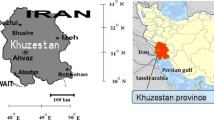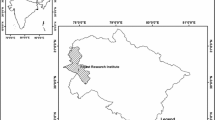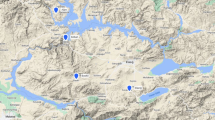Abstract
The Penman–Monteith equation (PM) is widely recommended because of its detailed and comprehensive theoretical base. This method is recommended by FAO as the sole method to calculate reference evapotranspiration (ET0) and for evaluating the other methods. The objective of this study is to compare PM using hybrid of artificial neural networks and algorithm genetic (ANN–GA) and artificial neural networks (ANNs) models for estimating ET0 only on the basis of the meteorological data. ANNs are effective tools to model nonlinear systems and require fewer inputs, and GAs are strong tools to reach the global optimal solution. The weather stations selected for this study are located in Esfahan Province (center of Iran). The monthly meteorological data from 1951 to 2005 have been used for this study. The meteorological data were maximum, average and minimum air temperatures, relative humidity, sunshine duration and wind speed. The ANNs and ANN–GA models learned to forecast PM reference evaporation (PM ET0). The results of this research indicate that ANN–GA predicted PM ET0 better than ANNs model.

Similar content being viewed by others
References
Allen R.G., Jensen M.E., Wright J.L., Burman R.D.: Operational estimates of reference evapotranspiration. Agron. J. 81, 650–662 (1989)
Penman H.L.: Natural evaporation from open water, bare soil and grass. Proc. R. Soc. Edinburgh 193, 120–146 (1948)
Jensen M.E., Burman R.D., Allen R.G.: Evapotranspiration and irrigation water requirements, ASCE Manual and Report on Engineering Practice No 70. ASCE, NY (1990)
Allen, R.G.; Pereira, L.S.; Raes, D.; Smith, M.: Crop evapotranspiration. Guidelines for computing crop water requirement. Irrigation and Drainage Paper No. 56 (1998)
Droogers P., Allen R.G.: Estimating reference evapotranspiration under inaccurate data conditions. J. Irrig. Drain. Eng. ASCE 16, 33–45 (2002)
Sudheer K.P., Gosain A.K., Ramasastri K.S.: Estimating actual evapotranspiration from limited climatic data using neural computing technique. J. Irrig. Drain. Eng. ASCE 129, 214–218 (2003)
Bruton J.M., McClendon R.W., Hoogenboom G.: Estimating daily pan evaporation with artificial neural networks. Trans. ASAE 43, 491–496 (2000)
Trajkovic S., Todorovic B., Stankovic M.: Forecasting reference evapotranspiration by artificial neural networks. J. Irrig. Drain. Eng. ASCE 129, 454–457 (2003)
Keskin M.E., Terzi O.: Artificial neural networks models of daily pan evaporation. J. Hydrol. Eng. ASCE 11, 65–70 (2006)
Kisi O.: Generalized regression neural networks for evapotranspiration modeling. Hydrol. Sci. J. 51, 1092–1105 (2006)
Kisi O.: Evapotranspiration modeling from climatic data using a neural computing technique. Hydrol. Process. 21, 1925–1934 (2007)
Parasuraman K., Elshorbagy A., Carey S.K.: Modeling the dynamics of the evapotranspiration using genetic programming. Hydrol. Sci. J. 52, 563–578 (2004)
Sudheer K.P., Gosain A.K., Rangan D.M., Saheb S.M.: Modeling evaporation using an artificial neural network algorithm. Hydrol. Process. 16, 3189–3202 (2002)
Kisi O.: Daily pan evaporation modeling using a neuro-fuzzy computing technique. J. Hydrol. 329, 636–646 (2006)
Kumar M., Raghuwanshi N.S., Singh R., Wallender W.W., Pruitt W.O.: Estimating evapotranspiration using artificial neural network. J. Irrig. Drain. Eng. ASCE 128, 224–233 (2002)
Kisi O., Ozturk O.: Adaptive neuro-fuzzy computing technique for evapotranspiration estimation. J. Irrig. Drain. Eng. ASCE 133, 368–379 (2007)
Dingman S.: Physical Hydrology. Macmillan, New York (1994)
Fausset L.V.: Fundamentals of Neural Networks: Architectures, Algorithms and Applications. Prentice Hall, Upper Saddle River (1994)
Neurosolution 5. Ward systems group, Inc., MD, USA (2008)
Garson G.D.: Interpreting neural-network connection weights. Exp. Syst. Appl. 6, 47–51 (1991)
Cook D.F., Ragsdale C.T., Major R.L.: Combining a neural network with a genetic algorithm for process parameter optimization. Eng. Appl. Artif. Intell. 3, 391–396 (2000)
Petridis, V.; Kazarlis, S.; Felelis, A.: A hybrid genetic algorithm for training neural networks. In: Proceedings of ICANNs 92, Brighton, pp. 953–956 (1992)
Odhiambo L.O., Yoder D.C., Hines J.W.: Optimization of fuzzy evapotranspiration model through neural training with input–output examples. J. Transp. Eng. ASCE 44, 1625–1633 (2001)
Author information
Authors and Affiliations
Corresponding author
Rights and permissions
About this article
Cite this article
Eslamian, S.S., Gohari, S.A., Zareian, M.J. et al. Estimating Penman–Monteith Reference Evapotranspiration Using Artificial Neural Networks and Genetic Algorithm: A Case Study. Arab J Sci Eng 37, 935–944 (2012). https://doi.org/10.1007/s13369-012-0214-5
Received:
Accepted:
Published:
Issue Date:
DOI: https://doi.org/10.1007/s13369-012-0214-5




